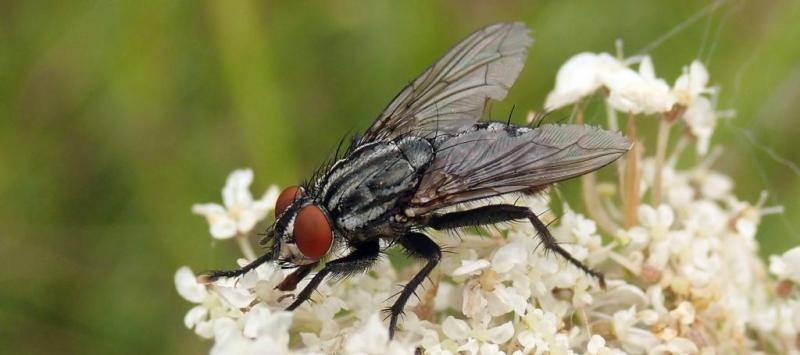
Sarcophaga vagans male on Angelica flowers. A widespread flesh fly.
- Taxonomic Group (English): Flesh flies
- Taxonomic Group (Scientific): Diptera: Sarcophagidae
- Scheme Organisers: Daniel Whitmore and Nigel Jones
NEWS
Scheme information
Collecting and preparing Sarcophagidae. Our tips for optimal collecting and preparation of Sarcophagidae for identification and recording purposes can be downloaded here. Any feedback and questions are most welcome!
Identification keys. See the link in the News section, above, for the latest version of the key to adult Sarcophagidae. User feedback is most appreciated and contributes to improving the key.
Records. Submit your records in Excel format to ukfleshflies[at]gmail.com or directly on iRecord, if possible with diagnostic photos to facilitate verification.
Contacts. For any queries, please contact us by email or via our contact forms:
Social media. Join the conversation in our Facebook Group and on Twitter!
Additional resources. A great and frequently updated resource is Steven Falk's collection of flesh fly images on Flickr.
What are flesh flies?
The calyptrate family Sarcophagidae (Diptera: Oestroidea) includes 65 species occurring in the British Isles. These include the well known "flesh flies" in the genus Sarcophaga, medium to large sized flies with tessellated patterns on the abdomen. Sarcophaga species are frequently seen basking on sunlit fences, rocks and other structures. They also engage in "summiting" at hilltops and other high points in landscapes.
The family contains three subfamilies:
Miltogramminae: Kleptoparasites of solitary wasps and bees, sometimes known as "Satellite flies" from the habit of some species of closely following host species back to their nests.
Paramacronychiinae: Flies with a diverse biology ranging across necrophagy and predation of snails to parasites or parasitoids of mammals and insects.
Sarcophaginae: The typical "flesh flies" described above. Their biology is very varied and includes predators and parasitoids of various insects, breeding in animal faeces, carcasses, dead snails, decomposing organic matter. The biology of many species is poorly understood or completely unknown.
